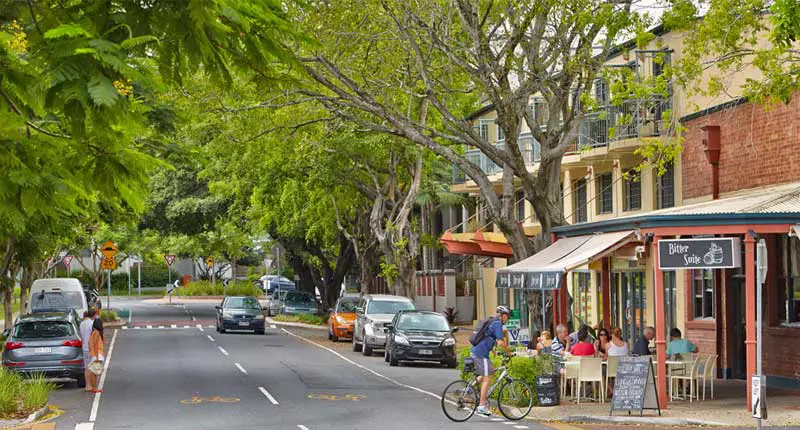

New Farm

New Farm is one of Brisbane's most cosmopolitan suburbs, and contains many of the cities trendiest bars and restaurants. Thanks to its proximity to the city and riverside location, it is also becoming one of Brisbane's most prestigious suburbs.
The suburb derives its name from the fact that the peninsula was used as a farming area in the early years of Brisbane's history. Brunswick Street is the main street running northwest-southeast up the centre of the peninsula. To the south of Brunswick Street the suburb is characterised by large ornate Queenslander-style houses, shady streets lined with large trees and tall apartment buildings, predominantly along the river. More modest Queenslander-style houses dominate the north of Brunswick Street, where there are fewer large trees and apartments.

The suburb has one main commercial area close to New Farm Park, called 'Merthyr Village'. A wide variety of businesses also operate along Brunswick Street and in adjacent streets. The former electric tramway power station, located at the eastern corner of New Farm Park, has been converted into a community arts and performance space called 'The Powerhouse'. New Farm is known as Brisbane's "Little Italy" as many immigrants from Italian descent first settled in the suburb.
Shopping
New Farm's main retail strip is found on James St. The James St Market is the flagship retailer in the area, and features a great fresh food market and cafes. The area's affluent image means New Farm's retail space includes plenty of high end boutiques. From fashion to home entertainment, there are plenty of places to give the credit card a work out on James St.New Farm Farmers Markets: the New Farm Park/Powerhouse Farmers' Markets are held on the second and fourth Saturday of every month.
Barefoot Bowls: Kick off your shoes, bring your friends, workmates, family, and spend a session with us the instructors, showing your talents for lining up a 4 pound ball and bowling it 120 feet to the jack. Mixed with queensland sunshine, outdoor seating and cold drinks with cooler paks, it makes for a great afternoon. The famous BBQ and Bowls make a great day or evenings entertainment. Location: New Farm Bowls Club, 969 Brunswick Street, New Farm. Ph (07) 3358 2374.

Brisbane Powerhouse
New Farm is home to the Brisbane Powerhouse, the former electric tramway power station which has now been turned into a premier performing arts space. The Powerhouse is also home to the trendy Watt restaurant. An arts and cultural hub, the venue offers an array of performing arts, visual arts, festivals, and free community events. Location: 119 Lamington St, New Farm. Phone: (07) 3358 8600
New Farm Park
Only three CityCat stops from the Central Business District, the inner-northern village of New Farm has long been a place to connect with others. Relax in the beautifully shaded surrounds of New Farm Park, where picnickers seem almost permanently perched on deck chairs and checked rugs. The historic Brisbane Powerhouse ia situated right next to New Farm Park.Though one of Brisbane's oldest suburbs, the peninsula of New Farm was once called `Binkin-ba' by the Aborigines. According to a recent book, Reflections on New Farm, published by the New Farm and Districts Historical Society the area was also a working site of convicts (lime kilns dating back to 1870 are still evident on the river banks) a marine base in World War II and home to many wealthy merchants and lawyers.
From 1885 to 1897 New Farm's transport needs were met by horse-drawn trams, which operated along Brunswick Street, as far as Barker Street. In 1897 the horse trams were replaced with electric trams and the line was extended, with trams ultimately running as far as Macquarie Street and down to the river at New Farm Park. The electric trams ceased operation on 13 April 1969. Since then the suburb has been served by diesel buses.
New Farm developed a reputation in the late 1980s as a drug-addled, low-rent culture depicted in Andrew McGahan's grunge novel Praise, which is set largely in the suburb. Since then, and like many Brisbane suburbs, New Farm has experienced much 'gentrification' and 'infill development' throughout the 1990s and the years since 2000. However, New Farm maintains its diversity, being known for its long-established Anglo-Saxon and Italian communities (as depicted in Venero Armano's novel Firehead), and its many restaurants and cafes.
How to get there
New Farm is an inner suburb of Brisbane, 2 km east of the Brisbane CBD on a large bend of the Brisbane River. New Farm is partly surrounded by the Brisbane River, with land access from the north-west through Fortitude Valley and from the north through Newstead.By Ferry: At the river end of Brunswick Street a small cross-river ferry, operated by Brisbane Transport links New Farm with Norman Park. New Farm can also be accessed via two CityCat stops (operated by Brisbane Transport) - at Sydney Street and at New Farm Park.
By Bus: The suburb is serviced by several bus routes to and from the city centre.

Teneriffe
Originally a farming area and later an industrial hub with boat moorings and commercial wool stores, neighbouring Teneriffe has undergone an urban resurgence and where apartments have sprung up, restaurants, cafes and boutiques have followed. Defined as a separate suburb until the early twentieth century, Teneriffe Park (44m) is the locality's most prominent hill, from which numerous minor streams ran down into Newstead or to the river.The hill was probably named after Teneriffe in the Canary Islands, off north-west Africa, in the 1850s. Bulimba ferry and Hawthorne ferry crossed the river's Bulimba Reach, along which Brisbane's main commercial wharves were built. Important facilities included the Bulimba Wharf (1906). As wool exports from Queensland increased in the early 20th century, the economic importance of Teneriffe to the state also increased.
The first wool store was built in 1909, with another three stores opening by 1915. During the early 1930s, when wool contributed 50 percent of Queensland's total exports, Brisbane averaged ten wool sales a year, and more stores were built. The last two were constructed during the 1950s in response to a worldwide boom in wool useage at that time.









